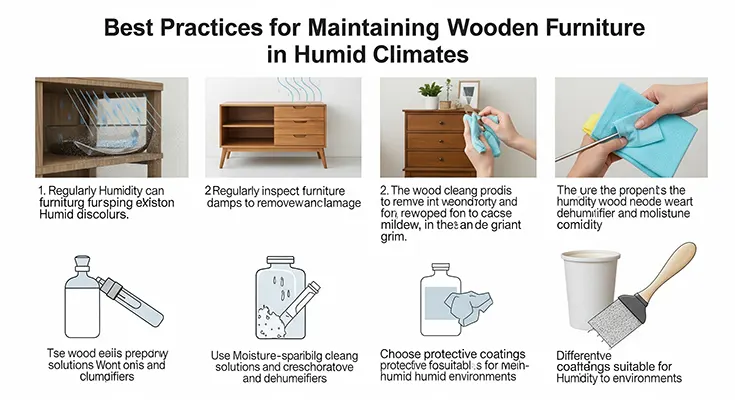Wooden furniture can bring warmth, beauty, and a touch of natural elegance to any space. However, in humid climates, the excess moisture in the air can pose challenges for the upkeep of wooden furniture. To preserve the luster and integrity of your wooden pieces, it’s important to implement best practices for maintenance in humid environments. By following these guidelines, you can safeguard your furniture against the potential damaging effects of high humidity, ensuring its longevity and enduring appeal.
1. Opt for Hardwood Furniture:
When selecting wooden furniture for a humid climate, consider opting for hardwood varieties such as teak, mahogany, or oak. Hardwoods are less prone to warping, swelling, or splitting in high humidity, making them better suited for such environments compared to softwoods. Additionally, hardwoods are naturally more resistant to moisture, minimizing the risk of damage due to fluctuating humidity levels.
2. Use a Dehumidifier:
In regions with consistently high humidity levels, investing in a dehumidifier can help regulate the moisture content in the air. Placing a dehumidifier in the vicinity of your wooden furniture can prevent excessive moisture absorption, reducing the likelihood of swelling or warping. By maintaining a controlled humidity level, you can protect your wooden pieces from the adverse effects of damp conditions.
3. Regular Dusting and Cleaning:
Regular dusting and cleaning are essential to prevent moisture and mold buildup on wooden furniture. Use a soft, dry cloth to remove dust and debris from the surfaces of your furniture. In humid climates, it’s crucial to keep furniture dry and free from excess moisture to mitigate the risk of mold growth, which can weaken and tarnish the wood.
4. Proper Ventilation:
Ensuring adequate ventilation in the living spaces can help prevent stagnant air and moisture buildup around the furniture. Good air circulation can contribute to maintaining a more balanced humidity level, reducing the likelihood of prolonged exposure to high moisture content that can compromise the integrity of the wood.
5. Apply Protective Finishes:
Applying appropriate protective finishes, such as varnish, lacquer, or polyurethane, can create a barrier that shields wooden furniture from the effects of high humidity. These finishes can help seal the wood, reducing its susceptibility to moisture absorption and contributing to its longevity. Periodically inspect the condition of the finishes and reapply them as needed to maintain their effectiveness.
6. Avoid Direct Sunlight and Heat Sources:
In humid climates, it’s important to protect wooden furniture from direct sunlight and excessive heat, as these factors can exacerbate moisture-related issues. Prolonged exposure to sunlight and heat can lead to drying and warping of the wood. Position furniture away from windows and heat sources to minimize the impact of these environmental stressors.
7. Seasonal Maintenance:
Conduct seasonal maintenance on your wooden furniture to address any changes resulting from varying humidity levels. Check for signs of warping, cracking, or mildew, especially during weather transitions. Making timely adjustments and repairs can help preserve the condition of the furniture and mitigate the effects of fluctuating humidity.
Maintaining wooden furniture in humid climates requires proactive care and attention to prevent the detrimental effects of excessive moisture. By choosing suitable hardwood varieties, regulating humidity levels, maintaining cleanliness, and applying protective measures, you can ensure that your wooden furniture remains resilient and visually appealing for years to come, even in the face of challenging environmental conditions.










